History and present days
Location
Walking on the slope, one comes across the Cell of Saint Artemios. It was built in 1870 by the monk Artemiοs. The vegetation is dense. A torrent descends the western slopes of the Antiathon (1,038 m high). Next to the mouth of the torrent there are the arsanas and the Gregoriou Monastery. The safe little cove of the monastery, as well as the verdant landscape together with the torrent, create a wonderful picture. However, the reality is quite different. During winter the torrent floods cause great damage to the monastic structures.
The passage from Simonopetra to the Gregoriou Monastery is a road from the highlands to the coastal area. The latter is built on a rock beside the sea, not much higher than the arsanas of Simonopetra. The 18th and 19th century engravings depict the monks fishing by a fishing line they throw from the windows of their cells. Even today, on the railings of the balconies of the workhouse next to the arsanas, one can see lines tied with a bell that warns the monks if a fish has been caught. The proximity of the monastery to the sea is relevant to the fact that it is dedicated to Saint Nicholas.
On September 21st of 1853, in the middle of the night, there was a second and worse flood that completely took from us the arsanas, together with 4 boats. It destroyed us. It ruined the streets of the Monastery on both sides, the mill was blown up from its foundations, it destroyed the whole waterway, while the house was filled with sand. (Testimonies of the monks, Varlaam (Angiakos), The Holy Monastery of Saint Gregory in Mount Athos, 1921)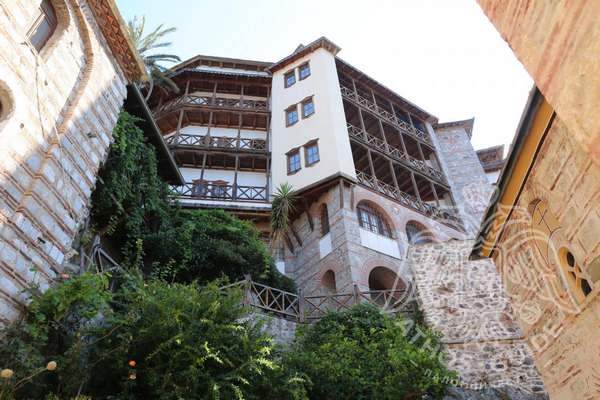 .
.
At the base of the rock where the monastery is built, under the north-western wing, there are remains of a building that must have been the original arsanas. It was probably abandoned at the end of the 17th-early 18th century. Next to it there is the present arsanas, which began to be used (or reused) when the newer arsanas, built on the left of the pier next to the mouth of the torrent, was destroyed by flooding. The arsanas has a nave on the ground floor, while on the first floor it houses the chapel of Saint Modestus, living quarters and storerooms. In the past there was also a space to accommodate crews seeking shelter in stormy weather. A built-in inscription informs the visitors that the church was renovated in June 1821. In 1991 the chapel of the holy martyrs Raphael, Nicholas and Irene was built next to the arsanas. Next to the newer structure to the left of the pier, there was the old stable, which was restored in 1987 and is now used as an additional guesthouse for pilgrims that arrive in great feasts.
A paved path leads from the arsanas to the monastery. The old workers' house (1850), on the left, is today used as a machine shop, a sewing room and a Byzantine music school.
History
The name of the monastery was taken from the name of its founder, Saint Gregory Palamas, a disciple of Saint Gregory of Sinai, who was its first abbot. Before the foundation of the monastery, he was a monk in a cave near the present-day Kathisma of Theotokos. Based on a manuscript preserved in the monastery, the foundation of the Gregoriou Monastery dates back to 1310. Written references are found in documents of 1347 and 1348. In the 3rd Typikon of Mount Athos (1394), the monastery is ranked in the 22nd place among the 25 monasteries of that time.
The information we have about the first period of its history is scattered in different texts. In 1497 it was deserted for an unknown reason, that could possibly be a pirate raid. In 1500 it was renovated from the ground by Stephen of Moldavia. His generous sponsorships and donations continued by his successors until 1720.
In 1574 the monastery took the 17th place in the hierarchy of the Athonite institutions, which it still holds today. In 1761 a fire destroyed it completely and left it deserted. It was reconstructed thanks to the tireless efforts of the sacristan Joachim Vesmintarios, better known as Makrygenis (Long-bearded, it is said that his beard reached his knees), from a village of Akarnania. Joakim was a monk in the monastery. However, he soon retired to the Skete of Saint Anna for more peace and quiet. He took on the duties of sacristan [financial administrator of the monastic property] at the request of many Gregorian fathers. The financial costs of the reconstruction were covered by the sponsorships of the rulers of Moldavia and the Phanariots, as well as by fundraising. At that time the existing katholikon was also rebuilt with the personal work of the monks. Additionally, Joachim built (1785) from the foundation the Monastery of the Transfiguration on the island of Propontis.
Joachim died at the age of 105. His example was imitated by other hierarchs, such as the Metropolitan Gregory of Skopelos and the Metropolitan Damaskinos of Argyrokastro, who both retired to the monastery and became monks when they gave up their duties. Several abbots and monks are mentioned as co-founders of the monastery. Among them there are Joachim's neighbor Constantius, Dionysius from Polygyros, Gabriel and Efthymios from Kassandria, Christopher and Agathaggelos from the Parthenon of Sithonia, Cyprian from Arta and Simeon from Kastoria.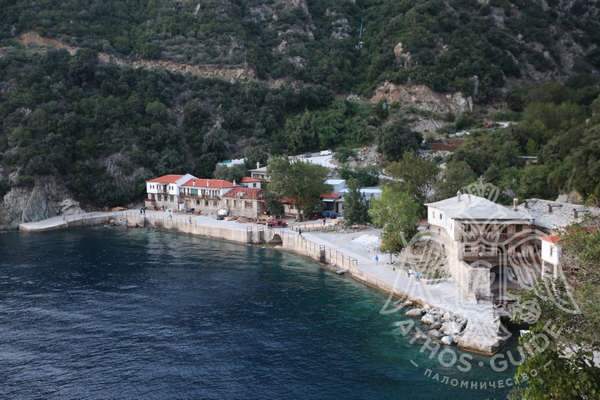
How and why was the Gregoriou Monastery honored in the name of Saint Nicholas? This was done to replace the Temple of Poseidon, which was then located in the small cove of the monastery, the only suitable for docking the sailing ships on the southwestern side. Today there is still a cave on the south-eastern side of the monastery, which bears the name of Poseidon's Dome. Indeed, the god of the sea of the Greeks in this picturesque location of Athos had to be replaced by the preeminent "Saint of the sea" of the Christians. (Varlaam (Angelakos), The Holy Monastery of Saint Gregory in Mount Athos, 1921.
The monastery was seriously damaged by the Ottoman troops that settled in Mount Athos during the period of 1821-30. Many of the monks left with holy relics and sacred vessels. They fled to the rebellious Greece. They ended up in Sifnos, from where they returned to the monastery. In 1820/21 and 1853 the monastery suffered extensive damage from floods, while in 1890 a fire burned down part of its forest. It stopped by the miraculous intervention of Saint Anastasia of Rome. In 1840 the monastery was converted into a commune thanks to the efforts (1830-40) of the scholar monk Gregory of Byzantium († 1841) and the support of his friend, Metropolitan Anthimos II of Ephesus.
The first abbot of the monastery was the monk Neophytos, a disciple of the abbot of the Esphigmenou Monastery Theodoritos, who was a monk in the Skete of Saint Anna. He was succeeded (1848-59) by Daniel from Zagora, who built the chapel of Saint Gregory next to the katholikon (1851). The monastery experienced a second period of great prosperity during the reign of Simeon from Tripoli (1849-1905), who came from the cenobitic monastery of Saint Paul and managed to cope with the monastery's enormous debt, thanks to the prudent management of the monastery’s structures in Wallachia. During his time the monastery doubled in size. There was also constructed the entire north wing with the new entrance.
The Gregoriou Monastery was in various periods of time home to the holy new martyrs Luke the Mytilenean († 1802), Gerasimos the New († 1812) and Ignatius the New († 1814). Additionally, Saint Akakios passed some time as a monk in the Kathisma of Theotokos, before settling in Kausokalivia.
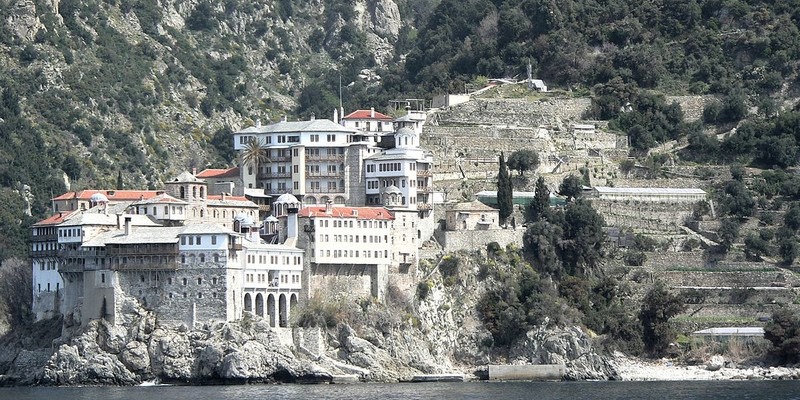
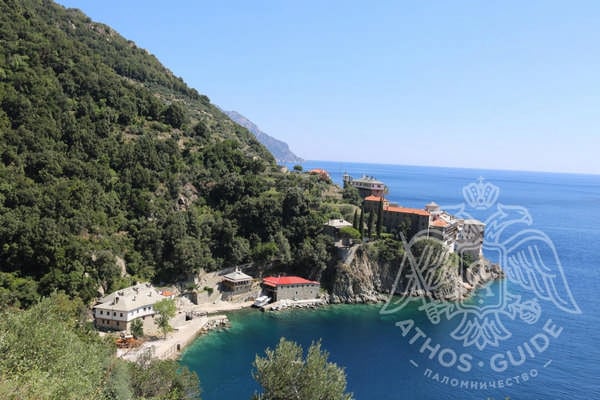

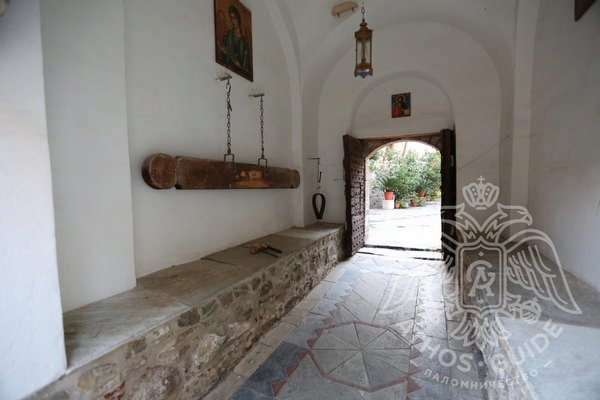
 In the monastery it is located a piece of wood of the Holy Cross. There are also the relics of Saint Gregory of Sinai and a great part (shins, left foot, right hand with her skin) of the relics of Saint Anastasia of Rome, who is particularly venerated in the monastery.
In the monastery it is located a piece of wood of the Holy Cross. There are also the relics of Saint Gregory of Sinai and a great part (shins, left foot, right hand with her skin) of the relics of Saint Anastasia of Rome, who is particularly venerated in the monastery.



